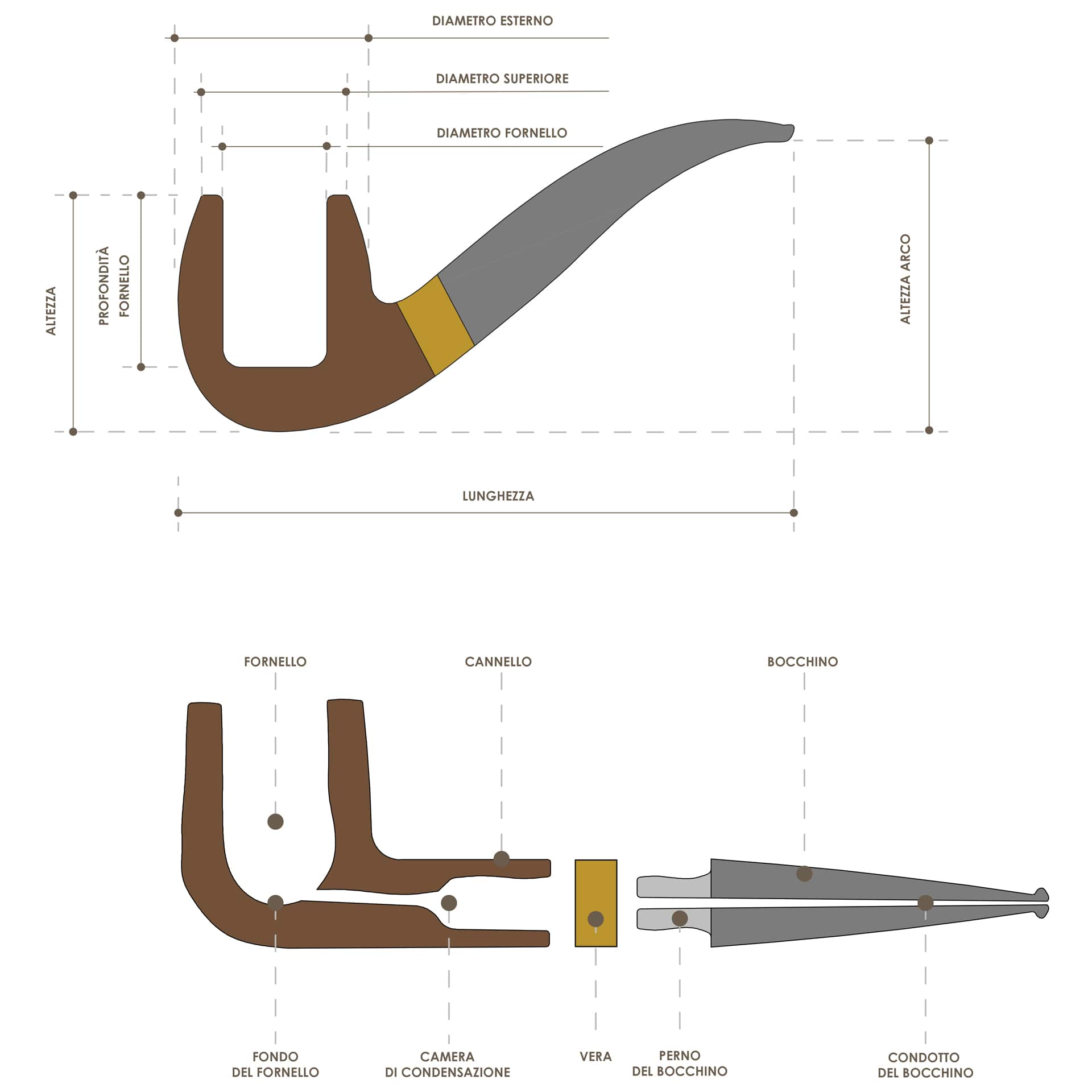Vademecum Pipe
Pipe choice
The choice of a pipe is not just a question of cost, quality, workmanship, grain, finishing or shape; the shape of the pipe must be close to the smoker’s face and be adapted to his appearance and style and personality, so we frankly advise you not to be influenced by pre-established formats and tips searched on the net but to “buy the pipe you like best! ”
This object must help solve problems and not create new ones …Then there are the criteria and rules that allow us to be able to buy a good quality pipe so it is important to put yourself in the hands of an expert and reliable dealer who will guide you patiently in the world of briar.
Good operation
This topic is an aspect on which fundamental attention must be paid. To make sure that the pipe works properly, first of all it is necessary to carefully examine the inside of the stove and verify that the suction hole of the torch is axial to the mouthpiece and that it is absolutely on the bottom to avoid lateral burnings of the stove and sudden breakings of the briar.
Secondly, the same control of perfect axial forage must take place at the intersection between the mouthpiece and the torch, verifying that the regular passage of a cleaning brush is allowed and decreasing the possibility of formation of drizzle.
Finally, check that the mouthpiece / stem connection is regular and firm at this point once these tests have been passed, the pipe should not give disappointment.
Straight or bent?
Two more words on: “Dritta” or “Curva”?
Many smokers, especially beginners, are bothered by the phenomenon of smoking, mainly due to the change in temperature that the smoke takes on entering the torch and (due to imperfections in the hole) passing through the mouthpiece, which is the so-called “acquerugiola”: that is a minute condensation that transforms itself, by cohesion into small droplets. This is not the most appropriate place to illustrate how the inconvenience can be overcome, however it is necessary to say that this phenomenon is felt more in pipe curves than in straight ones, which is why, with regard to the question, we recommend, at least to the beginner a straight pipe. The expert will not have problems to remedy the problem. The above is more than enough to deal with the shopkeeper’s argument file before choosing the pipe.
Dritta | Straight

Semicurva | Half-Bent

Curva | Bent


First smoke: the break in
New pipes in most cases have natural internal walls of the stove, ie without any treatment (layer of dark carbonic substance that pre-replaces the crust) this would always be better desirable to see how the rootwood looks inside. The layer used to isolate the briar from any burns and to avoid thereby irreparably ruining the pipe is called a “crust”.
The correct way to start a beautiful pipe requires about twenty smokes to be burned and according to the smokers’ experiences, the rind would have a fundamental role to let the pipe burn out, eliminating that sour taste typical of virgin briar, usually rich in tannins. In other words, in the briar pipes the crust seems to refine and round off the taste of smoke; during this phase the wood fibers absorb and retain the tobacco substances acquiring an original flavor that accompanies, “colors”, defines and in some cases enhances the actual smoke produced during combustion. This aspect is especially noticeable when tobacco products are smoked which, in general, have a not very intense taste, so much so that in porcelain or foam pipes they pass rather unnoticed. Starting from this perspective, it can be seen that the running-in should take place with certain criteria that also include an attention to the type of tobacco to be used for the baptism of the pipe so that the latter matures satisfactorily and has a crust with a clear taste. But we’ll talk about this later.
Turning to the actual running in, the initial phase becomes neuralgic when a new pipe needs to get used to the heat that is also linked to the amount of burnt tobacco. For this reason, the rules of classic break-in require that for the first 4/5 smokes the stove is only half loaded until it is filled gradually during the subsequent smokes. This technique is aimed above all at the neophyte because it allows him to control the smoke without overheating the stove, giving him time to learn a technique that makes it more casual afterwards.
Other more experienced smokers, on the other hand, like a “full” break-in involving a conception and a technique of running in opposite to those described above. It consists, in fact, of filling the new pipe completely immediately, smoking it a number of times a day which varies according to the habits of the smoker. In this way the greater heat that develops opens the pores of the briar allowing it to transpire more and thus favoring the absorption of the aromatic substances of the tobacco that determine, as we have said, the “maturation” of the pipe.
Use of tobacco for break-in
An aspect to be emphasized is that during the break-in phase it is suggested not to change tobacco or at least to maintain the same type to prevent the pipe from getting too flat and poorly defined.
But which is the tobacco to use for the break-in? Is there a tobacco more suitable than others for this phase? In this case there is no objective and valid answer for everyone; we only investigate the behavior of smokers and try to derive reasonable motivations. Running in with natural shredded and pipe versatility.
Some advise natural tobaccos based on Kentucky like our common which is a rich shredded but rather neutral taste that does not compromise that of the subsequent tobaccos and that gives the pipe a preliminary flavor that prepares it to define and reveal at best the nuances taste of various blends.
From an exclusively functional point of view, this shredded is rather dry with a medium cut perfectly in line with the classic shredding. This dryness allows it to burn very quickly and immediately form the crust because it immediately favors the caramelization of sugars since it has very little humidity. Obviously, as with so many other aspects concerning pipe smoking, the use of a natural shredding for running in is not a fixed rule or an obligatory passage but only a suggestion dictated by actual feedback in many smokers. Starting from the point of view of the neophyte who has the tendency to experiment continuously, we can interpret the break-in as a way to make the pipe versatile with different tobaccos; by virtue of this it seems appropriate to put it in a position to do so by adopting some precautions.
In fact we must take into account that, at least according to a certain literature, a crust produced by the combustion of a natural shredded, as not particularly rich in fruity essences, brings the pipe to be more receptive to the most varied types of shredded and mixtures that the market offers .
Echoing his supporters, we can say that the running with these shredders is able to reveal the peculiar characteristics of a pipe and bring out strengths and weaknesses; other tobaccos do not allow it because maybe they are too invasive or too sugary and prevent the briar from showing its taste.
How do you smoke the pipe?
Loading the Tobacco chamber
To enjoy a good smoke the way you load the stove is crucial, this operation requires some attention for the first few times, then it will become a mechanical ritual. First of all, choose a tobacco that is slightly moist to the touch and chop it until you have a homogeneous set of filaments no longer than one centimeter and eliminate waste such as ribs and woody parts because they will burn badly. If the tobacco is too moist you can also let it dry for half an hour on a sheet of paper, making it oxygenate well. You can now proceed to fill the stove with tobacco. Keeping in mind that a good loading is directly proportional to a good smoke as a result a poorly charged pipe could compromise the combustion of the tobacco by turning off often.
Loading in three phases is preferable:
FASE I
First place a light layer on the bottom of the stove without pressing.
FASE II
it follows a second layer accompanied by a slight pressure by uniformly settling the tobacco on the external wall in order to create a homogeneous and continuous stratification without the air pockets due to extinction.
FASE III
The third continuous part with a complete filling of the stove is a light but firm pressure combined with a moderate external vibration of the stove and filling it to the brim. To test a good load it is necessary to put the pipe in the mouth to make some raw pull where to feel a slight resistance is a symptom of a correct operation on the contrary if the draft is too free means that the pressure has been too light. If the draft is too much closed the pressure was too intense and in both cases it is necessary to empty the pipe and repeat the procedure. Before switching on, it is advisable to practice by repeating this operation several times.
Power on
This operation is also important because together with loading it ensures continuity and taste in the smoke, ignition must be carried out carefully, especially the first few times so that the inconvenient pipe extinguishing does not occur, which discourages the neophyte more than any other.
Given that the loading was carried out correctly, the ignition should not present obstacles. First of all, to make it, we recommend the use of wooden matches or a lighter with a vertical pipe flame.
A tip is to try to avoid plastic matches or old-fashioned gasoline lighters to avoid compromising the taste of the wonderful tobacco.
Therefore bring the flame close to the stove starting from the peripheral part to then pass to the central one so that the entire surface of the tobacco is covered by the flame so as to allow a homogeneous combustion is an easy exchange of oxygen.
The pipe must now be held firmly in the mouth accompanied by some decisive “puffs” seeing the combustion of the upper layer of tobacco uniformly formed.
Smoke, keep burning
When ignited correctly it must follow a good combustion of the smoke, one can already start with a first delicate pressure to the surface turned on to reduce the inflated tobacco turned into embers drawing at the same time and pulling with small puffs to establish a superficial homogeneity; as you go by quietly, rhythmically, enjoy the pleasures of your new company, remembering that the pipe smoke as for the cigar does not go down, it is savored between the palate and the nose trying to perceive the taste and the harmonious notes of the various blend.
The cleaning
When the smoke is coming to an end, the embers now affect the bottom of the stove and risks stagnating because they no longer have the underlying tobacco to burn. We therefore find towards the end of the smoke, a situation in which a warmer smoke is transmitted to the smoker with a sour and pungent taste, combined with an unpleasant hint of stickiness and bitterness. At this point the pipe must be emptied immediately to avoid even overheating the root and causing damage or cracks. Now go to the emptying of the stove specifying that last operation if carried out carefully guarantees a future of good smokes. empty the pipe from the ash carefully by beating it on a palm of the hand or on the cork of the beater to completely eliminate any carbon residue left in the stove. you can also use the pipe cleaner using it gently to remove ash and tobacco residues. It is important to respect the briar avoiding to beat it against hard and rigid surfaces not even against the heel of the Scarpa. When the pipe is cold, remove the mouthpiece and introduce a pipe cleaner into the pipe to clean and eliminate any intrusions and possible tar residues completing all with a nice blow to remove even the lint of the same.Repeat the same operation also for the part of the mouthpiece by cleaning the duct and drying the inside, when even the plug that enters the torch is well clear the pipe is ready for a proper rest !
Pipe shape
Straight or curved? is the question that arises the neophyte in the approach of the purchase of the first pipe. Through the two basic forms have been created over the centuries many shapes, some of which became part of the classification of the main forms, some labeled as “freehand” or free form, of the famous Italian masters or famous Danish artisans who have made school in the pipa market. artistic briar; let us now try to shed light in this paragraph on the main forms on the market.
AUTHOR
The Author: the older sister of the Prince form, the Author has the same flattened shape as the bottle, but it is a little larger. The heavy stove of the author is at the end of a massive shin which almost always has fold from 1/8 to 1/4. Its thick walls help keep the stove warm and guarantee a comfortable grip.The Author is usually preferable in a smooth finish and lends itself very well to a lighter color or even with a natural finish.The origin of the name Author derives probably from the ease and comfort with which it can be clamped between the teeth.
BOCCETTA | APPLE
The Apple: it is still similar to the billiard, but it differs from it for the profile of the paunchy stove, even if the combustion chamber remains practically the same. It has no particular contraindications, but it is not as “English” as the billiard. In the version with saddle mouthpiece it is considered suitable for sports people.
CLASSICA CURVA | BENT BILLIARD
The Bent Billiard: it is the most common among pipe curves, and it is the first one to be bought there. It has the same stove as the billiard, but a very good balance, due to its lower center of gravity than the end of the mouthpiece, which makes it easy to keep it in the mouth; his line encourages a comfortable armchair and a book: it gives an image of warm domestic intimacy. Grants relatively fresh smoke. The ease with which it is held in the mouth leads to the formation of a certain amount of drizzle. Suitable for mountain excursions and fishing enthusiasts, it is well seen in the mouth of mature or elderly people. Due to its predisposition to the drizzle it is not recommended for the beginner.
CLASSICA DRITTA | BILLIARD
The Billiard: is the pipe par excellence, the one that, as a child, was drawn in the mouth of the puppet; it is the most widespread pipe and it is, we think we can affirm, the first pipe that we think to buy. It is, above all, the most advisable for the beginner, because it is the easiest to use and because, being straight, it gives less drizzle. Its line, then, makes it suitable for every situation and at any time of day; it also takes up little space in your pocket.
BRANDY
The Brandy: today it is one of the most popular pipe shapes in the world, and it’s easy to see why. With fluid lines and elegant proportions, the Brandy has been aesthetically refined over many decades to resemble its namesake, the wide and bulging brandy glass, which welcomes tobacco giving a comfortable smoke, from armchair and fireplace. While the shape of the stove may vary considerably, the Brandys are recognizable by their broad and rounded base, which gradually tapers from the torch to the mouthpiece. Hand-made brandies generally show an even more voluptuous base of important shape and weight decided.
CANADESE | CANADIAN
The Canadian: very elegant pipe that reminds a little of the lovat, but with a longer stem and an oval section. As length is roughly equal to the billiard and, for this reason, it grants a fresh smoke but, still for this reason, it needs a greater care regarding the cleaning of the torch in which, more than in any other, it is easy the accumulation of tarry substances. Its particularly slender shape often combines it with young or sporty people. Given the length and the greatest fragility (due to the reduced section of the torch), it is not advisable to carry it in the pocket while traveling, but it will certainly be better, in this case, to store it in a special bag. It is not advisable for a beginner to take special care in cleaning. Finally, when it comes to smoking, the phenomenon of drizzle is less noticeable than the others.
CHERRYWOOD
The Cherrywood: it is one of the few forms that is always a “stand”, with a flat bottom, technically it is a subtype of the form of Poker; over the years pipe manufacturers have forced its evolution since its first appearance, which while maintaining some visual similarities with its parent, Poker, is an elegant shape with a distinct personality.
Cherrywood is a pipe with thick walls, and dimensions generous fit most of the time, to the combination that makes it a wonderful pipe to smoke and rest while enjoying a good drink, reading a newspaper or other similar activities that occupy the use of one’s hands.
CORNETTA / WOODSTOCK
The Woodstock: pipe from the original shape, slender and elegant, is suitable for sports people, for hunters and hi riders. It has only the inconvenience of having some difficulties in lighting due to the forward inclination of the stove which, among other things, resembles dublin. Also the control of the conduction of the smoke results, for this reason, less simple. It is certainly more suitable for young people than for mature people, unless they are athletes.
DUBLINO | DUBLIN
The Dublin: is a pipe with a decidedly elegant and slender line, also due to the slight tilt forward of the stove and to the upward flaring. It differs from the previous ones for the internal section of the inverted truncated cone stove. For this reason, it tends to overheat in the smoke, to give a warmer smoke and to give more drizzle. These negative factors must worry, however, only a beginner, who in fact is advised against; the beauty of the line, and its lightness make it accepted despite these small annoyances, which the expert considers of little account. As has been said, it is not suitable for the neophyte who, moreover, would risk burning it.
GALLES | PRINCE
The Prince: is a “quarter bent”, that is a fourth curve: it seems that its name derives from the fact that it was the favorite of the Prince of Wales, brother of George VI, who renounced the throne to marry the American Wally Simpon, remaining Duke of Winsdor. It has a very slender sports line and is very light. Its stove, which looks a bit like the apple but is lower, has consequently a lower capacity than the previous ones and a fresh smoke also depending on its length. It has the only drawback of granting a short smoke. Recommended for young people when they are smoking at first, those who switch from cigarettes to pipes and sportsmen.
LIVERPOOL
The Liverpool: it is actually part of the Canadian pipe family. What distinguishes Liverpool from the other pipes of the Canadian family is that Liverpool has a round stem with a full rounded mouthpiece, which makes it perhaps the most conventional of the group. Like the other types of the Canadian pipe family, the length of the torch should be about twice the height of its billiard-shaped stove.
LOVAT
The Lovat: it is similar to the billiard, of which a variant could be defined, differing only in the longer stem and. consequently, for the shorter and saddle mouthpiece: generally it is slightly shorter than the first and if, for this reason, from a slightly warmer smoke, it gains in balance, that is, it holds more comfortably in the mouth.
LUMBERMAN
The term “Lumberman” evokes images of beefy men in flannel shirts carrying freshly cut trunks through coniferous forests, yet the Lumberman pipe seems to contradict this imaginary in an unlikely way. The Lumberman is the last variant of the Canadian pipe family, a subtype of the billiard form.
What distinguishes the Lumberman from the other pipes of the Canadian family is the oval stem with a saddled mouthpiece, as for the other members of the Canadian family, a torch thin and long embellishes the stove bringing it to about twice the length of its height.
OOM PAUL
The Oom Pauls: does not attribute its uniqueness only to the strange shape, but rather to the union of various shapes and sizes.
The tobacco chamber of an Oom Paul has the form of a large billiard table with a generously sized tobacco capacity. Pauls are always completely curved, they have a torch of the same diameter as the stove and are often Stand up. Certainly one of the most interesting and bizarre form names probably tells a fascinating story. Stephanus Johannes Paulus Kruger, better known as Paul Kruger is affectionately known as Uncle Paul (in African “Oom Paul”) was President of the Republic of South Africa, Uncle Paul was often seen in public and was photographed with his favorite pipe, a Hungarian, which came down conspicuously from his mouth.
OVALINA | OVAL
The Oval: is the progenitors, the less widespread, and this is precisely because of the section of the stove that, if it would be preferred especially on the road or on the road thanks to its small footprint, on the other hand makes it little accepted by everyone for the difficulty ignition and conduction of the smoke: in fact, the embers has a constant tendency to gather in the center, leaving the tobacco unburned where the curvature of the wall of the stove is more accentuated. Consequently the progressive control of the smoke for this continuous tendency of the embers to gather in the center of the stove becomes difficult. His line, however, is pleasant, and so someone occasionally becomes pissed off. Needless to say, the beginner is only allowed to look at it.
PANEL
The pipes indicated as “panels” derive their originality not from a specific form, per se, but from a distinct aesthetic property, namely the flat panels on their stoves. Many pipes can be made with panels, including billiards, dublins, brandy, and more. The panels on the stove must also be in a predefined number and positioned symmetrically, even if there are panel pipes with six or eight sides that can have panels of variable width. This helps to differentiate a panel pipe from a Freehand, which can have one or more panels positioned at any desired interval. The billiard panel was originally a billiard table with four walls and a round shank, and with a square shank it is also called Foursquare.

POT
The Pot: also for the pot there is an analogy of form with the billiard, from which it differs for the stove, which has a larger diameter and is generally lower. Let’s just say that it is a pipe to recommend only to those who already have some experience, because smoking it involves firstly the aspiration of a warmer smoke, which a beginner would irritate the tongue at the first puffs, and secondly a greater difficulty in the power on. These two factors, which can only be considered negative by a beginner or by those who switched from cigarettes to the pipe, derive solely from the large section of the stove: with equal suction, a larger quantity reaches the mouth through the same torch hole of smoke that is compressed, so to speak, thus maintaining a high temperature. For this reason it is advisable to smoke it outdoors, adding fresh air to each puff and not one at a higher temperature than a closed environment. Special attention must then be paid to the conduct of the smoke: in fact, due to the width of the surface of the embers, it can happen that, sucking violently, this passes below, gathering in the center and leaving the tobacco unburned against the wall, thus favoring the extinction of the pipe. It is recommended for use on walks.
POKER
The Poker: Named for its ability to constantly sit on the poker table while mixing and playing, Poker is a stand up evolution of Billiard. The round stem comes out just below the bottom of the round cooker and is lengthened with a simple saddled mouthpiece.
QUADRA CURVA | RHODESIAN
The Rhodesian: it is the curve with the sportiest line, it has many affinities with the bulldog, from which it differs for having the most crushed stove. Well balanced, it is clearly seen in the mouths of those who practice mountain excursions, sportsmen and those who love reading. Not suitable for beginners.
QUADRA | BULLDOG
The Bulldog: it is a pipe with a very nice line, decidedly sporty and youthful. Its profile is decidedly detached from the traditional line of the previous ones: the only analogy preserved is the internal section of the stove, which remained practically unchanged. It holds well in the mouth for its short length compared to the billiard, and this makes it forgive the slightly warmer smoke than that. Maintenance is very easy. It is suitable for a young or sporty person, who particularly practices golf and tennis.
UOVO | EGG
The egg: it remains simply an increasingly rare historical shape to find due to the difficulty of combustion that involves the oval-shaped stove. This modest-sized pipe had the advantage of being easily placed in the jacket pocket. In fact it remains in the tradition classic of basic forms.
Stem shape
In English stem (American: shank), in French tige is the continuation of the stove towards the mouthpiece, a very important and delicate part of the pipe. It is generally of briar, that is of the same wood of the head, but it can be of bamboo or other woods and, in some pipes, of metal. In the numerous pipes in circulation you can find torches of round, oval, square, triangular section or of various combinations of these forms between them, basic is the harmony shaped with the pipe model, The same harmony is required for the length in proportions, in relation to the stove. The junction with the mouthpiece can be in contact, and then it must be ensured that there is perfect adherence and continuity between the two parts. As for the interior, the torch must be perforated perfectly, this is the main task of the craftsman . The diameter of the duct normally measures 3mm, such as that of the mouthpiece and the drilling work must give a precise alignment between the hole of the mouthpiece and the outlet hole at the exact level of the bottom of the stove. In the terminal part the inside of the torch widens to accommodate the plug or pin of the mouthpiece, of course, only in cases of abutment. In this area its walls are thus thinner and it is not uncommon for any forcing on the junction point to cause a crack in the wood, an inconvenience which can be remedied by the application of a real metal. it must accommodate, if possible, in perfect abutment otherwise it remains a kind of chamber in which the smoke expands with the effect of sudden cooling and therefore the formation of condensation. However, not everyone agrees on watertightness and there are those who prefer the pin of the mouthpiece does not take up the housing completely. This inner area of the torch is however subject to getting dirty more easily and therefore it must be cleaned frequently, using the pipe bender and the pipe cleaner.
Mouthpiece shape
The mouthpiece’s function is to carry the smoke from the torch to the mouth and allow the teeth to support the pipe; the aesthetic purpose is to complete the pipe line geometrically and harmoniously.
The essential features of a mouthpiece are:
Strength and durability combined with a minimum of elasticity and liking for teeth.
Absolute neutrality towards smoking, it is essential not to alter the taste of tobacco.
Slight cooling function on the smoke, to avoid excessive condensation phenomena.
Shape suitable for the shape of the briar and shine possibly long lasting.
Perfect geometric alignment of the torch, both externally and internally in the drilling.
A fundamental requirement: that it is “good in the mouth”, that is, it ensures a good grip without straining teeth and jaws. In the basic shapes of the pipes you can find 2 categories of mouthpiece: the Conical Mouthpiece (Tapered) of a conical shape precisely, also called a “full” mouthpiece (to distinguish it from the saddle mouthpiece which involves an “emptying” of material). The Saddle Mouthpiece (Saddle) which has a sort of step forming a thinning of the mouthpiece.
Within these two categories it is possible to give rise to two distinctions, Some differentiate the conical mouthpiece from what they call “modern conical” (Modern Tapered) which is not perfectly conical, but has a slight curved narrowing and ends with a final cylinder, between the saddle mouthpiece and conical mouthpiece do not involve substantial differences in smoking even if given the lower thickness the saddle mouthpiece allows a faster cooling of the smoke and an easier adherence between the teeth; the choice therefore between one or the other is purely subjective.
A special case is given by the so-called “Flock” mouthpiece (Army Mounted) composed of a mouthpiece with conical pin that is inserted directly into the torch, usually equipped with a precious metal ring. A typical example of a flock coupling is provided by Peterson Pipes where you will notice the absence of a stepped pin compared to a normal mouthpiece. In the universe of pipe smoking it is common to distinguish a flock graft from the so-called “Spigot” which is characterized by a mouthpiece and a torch both covered with precious metal in the final part, the flock and spigot graft have a great advantage given by the taper of the part inserted in the torch: they are extracted by straining less, which is why they can be “unscrewed” even during the smoke and allow the excess drizzle to blow out of the mouthpiece.
The shape of tooth: The shape of the tooth is a further detail that should not be underestimated, most of the pipes have the classic de tooth form called “Fish Tail”. Then there is the beloved Palatal Mouthpiece which directs the smoke on the palate rather than on the tongue.
Finally, the Dental Mouthpiece (Dental Lip) should be mentioned, more pronounced in the upper part, which allows the pipe to be held in the mouth without having to tighten the mouthpiece with too much force.
Mouthpiece materials:
The materials used for the construction of the mouthpieces are Ebonite, a compound of vulcanized natural rubbers to which sulfur has been added to reinforce it or Methacrylate a plastic material. In Anglo-Saxon terminology we speak of Vulcanite (even if the term is improper since it would actually designate a mineral) or Hard Rubber (literally “hard rubber”), respectively of Lucite (the mark of a Methacrylate). Normally the mouthpieces are produced in black, even if they can be produced in other colors. Famous is the striped Cumberland mouthpiece by Dunhill, the result of a particular color given to Ebonite mouthpieces. Methacrylate and Ebonite cannot be distinguished with the naked eye where the mouthpiece is new. However, Ebanite is softer between the teeth, which makes it preferable to the eyes of many pipers. The disadvantage is its wear. Over time and with the smoked Ebanite tends to assume a greenish / yellowish color that requires special cleaning to be restored to its original black color. At one time, however, especially during the nineteenth century, when Ebonite and Methacrylate were still not used, the craftsmen used various materials. Amber was a material currently used for high quality pipes such as sea foam pipes. Amber is still used today, but it is mostly synthetic amber. Ivory was also a viable alternative to luxury. For other, less prestigious pipes, simple wooden mouthpieces could be used, such as the cherry tree. Then there are animal horn mouthpieces (once very common), ivory or even briar (sometimes the pipe has no removable parts).
Vi sono poi bocchini in corno di animale (un tempo molto comuni), avorio o anche in radica (a volte la pipa non presenta parti amovibili).
Anatomy

Accessories
The pipe cleaner :
The pipe cleaner is the most useful accessory for the pipe smoker; it is used for managing the humidity that is created during smoking, as well as for cleaning the pipe itself; the correct use of the brush guarantees a good quality smoke and favors a correct maintenance of the pipe. The brush comes in the tubular form consisting of a metal or plastic core wrapped in cotton fibers and / or nylon fragments.
Three types of brushes are available on the market:
Absorbent: the coating is only cotton.
Abrasive: the covering is made of cotton and nylon fibers alternating between them.
Mixed: less used, one abrasive half and another absorbent.
Shape of the brush:
Adjust (fixed diameter along the entire length)
Conical (one end larger in diameter than the other).
The conical pipe cleaners should have a greater absorbency, but the regular ones are not less. The length of the standard pipe cleaners is about 15-16 cm, for the church garden they are longer than 20 cm. Finally, there are those sold by the meter (not available in Italy).
The quality of the brush is not to be underestimated, it is easily understood when the good product flexes but does not bend (steel core) and does not leave cotton residues during its passage.
Use During smoking, its main function is the management of the phenomenon that creates humidity between the hole in the stove (that of the smoke coming out) and the torch, this due to various factors, besides the annoying gurgling, alters the flavor of the tobacco.
In this case we intervene with the use of an absorbent brush (better regular; the conical ones could have difficulty in penetrating the hole of the mouthpiece). With the pipe fitted, insert the brush from the hole of the mouthpiece and reach the junction between the stove and the torch. Leave it for a few seconds and then extract it. It should be emphasized that the passage of the brush must not be prevented by any type of filter (metallic, balsa, foam, carbon); in this circumstance complete penetration is impossible.
For use After smoking, always let the pipe cool and then disassemble it, empty the stove and take an abrasive brush, folding it into a “U” shape and then inserting it in the stove with a rotary motion and along the perpendicular axis This eliminates the ash residues and some unburned tobacco particles attached to the inner walls of the stove.
Proceeding with the cleaning of the torch, we can follow the use of an absorbent brush (regular or conical) or an abrasive (regular or conical) or a mixture according to the degree of dirt of the torch. If cleaning is done regularly, the use of an absorbent is more than sufficient. The brush is then inserted into the torch (if it is tapered, the thicker end must be oriented towards the stove) and a movement is started along the longitudinal axis, until the residual humidity is not absorbed and the hole is not totally free. located between the burner and the torch for any ash and / or tobacco particles.
For the mouthpiece we use one of absorbent type passing from one end to the other two or three times, after which the pipe can be reassembled and put to rest. Some have the habit of leaving a pipe cleaner inserted during the resting of the pipe, in order to accelerate the elimination of humidity. For extraordinary cleaning of the pipe, the main problem is condensation and charred tar created over time in the pipe. torch, therefore an abrasive brush is taken, folded in two so that the two ends close together are inserted into the torch and a rotary movement is started along the longitudinal axis. If necessary, for pipes that are too dirty or not smoked for a long time, you can also use tar and nicotine solvents, wetting a part of the pipe cleaner.
IThe mouthpiece is cleaned in the same way but this time without bending the brush and preferably using an absorbent type. It is considered necessary to replace a new pipe cleaner with each cleaning to avoid residual waste materials and smells of extinguished smoke unless the pipe cleaner is still sharp and slender.
The Pipe Care:
The pipe cleaner is a tool designed to help load, smoke, and empty a pipe.
A typical open pipe cleaner. From the left to the right, the reamer, the needle and the pino are visible. A typical pipe cleaner is made up of three elements, a pigino, a reamer and a needle:
The needle is a sort of nail that serves to unclog the torch from any debris or to aerate the tobacco if it has been pressed a little too much. Being sharp, it could scratch the inside of the pipe stove and should therefore not be used for scraping. The reamer is an instrument that resembles a small sharp knife or a slightly flattened spoon; it is used to scrape ash or unburned tobacco from the sides and bottom of the stove. The pigino is a rounded instrument that usually has the shape of a nail head; it has a flat end that serves to press the tobacco when loading the pipe and to compress the ashes to facilitate re-ignition.
The filters
Filters help smoke the pipe more dry by absorbing condensation, lowering the smoking temperature by cooling the smoke, keeping the pipe cleaner and generally improving its taste, especially if you do not regularly clean it by retaining the impurities of the smoke such as tar and nicotine.Generally those who smoke sweet or aromatic mixtures prefer active carbon filters, which allow them to keep the smoke more dry and fresh, in fact leaves a less caramelous aftertaste and the so-called sweet tobaccos allow to find complicity even among the neighbors who they do not smoke and they smell very pleasant essences. Most veteran smokers do not like the use of the filter because they do not consume sweet and flavored tobaccos; convinced that the filter alters the flavor and aroma of the smoke; unlike the pipers of the south, the use of the filter is widely used in northern European countries where the more humid climates and the sweet tobaccos create much more condensation which would oblige their use.
Filters of various sizes and diameters are available on the market. and materials:
Activated carbon filters or sea foam
Balsa filters
Cellulose filters
Metal filters
Size:
3 mm filters
6 mm filters
9 mm filters
In conclusion we can say that the choice for the use of the filter is personal and subjective, it is therefore evaluated based on the needs of the customer before and after the purchase of the pipe.
Tobacco
Mixtures:
speaking of tobacco, and consequently of mixtures of the same, the subdivision of tobaccos into basic tobaccos and additives was generally adopted: the latter, besides conferring taste, strength and aroma, will also allow to attribute a name to the mixtures . To this subdivision, right at the bottom of the substance, can, like any rule, be an exception: in fact, a very common tobacco known as Cavendish can very well be used both as a base and as an additive, and so to speak of Burley. Another form adopted, less common but no less important, is the division of tobaccos due to their combustibility. However, not wanting to lose sight of the premise, which simply limits the complex matter to some information, let us return to the actual topic: the mixtures.
Characteristic of the mixtures:
a) Omageneity: in mixing the various tobaccos you should not possibly forget the use of tobaccos of the same cut.
b) Aroma: it is the characteristic of many mixtures and is due to one or more additives aromatic tobaccos that are mixed with basic tobacco.
c) Taste: it is characterized by the use of particular tobaccos that give a little name to the mixture: for example, mixtures of English, Danish, Dutch, etc.
d) Combustibility: it is a quality absolutely necessary for the mixtures to be smoked: they must therefore guarantee a regular course to the smokes burning neither too slowly nor too quickly.
e) Degree of humidity: it must not be excessive in order not to compromise the combustion and therefore the smoke: in fact, an excessive humidity obliges to frequent and intense puffs that bring the pipe to overheat, and it determines besides a warm and irritating smoke. On the other hand, it must not be absent, in order not to give rise to a dry and dusty mixture which, in addition to giving a hot and irritating smoke, would burn too quickly.
f) Cutting: it is the physical aspect of the mixture, through which the various qualities of the component tobaccos are presented; the most common cutting qualities are:
Shag (Chopped): stringy appearance of tobacco cut into more or less thin strips.
Fluke (Pressato): layers of tobacco leaves pressed and cut into thin sheets: it has the characteristic of having a strong humidity, thanks also to the additives and to the treatment of tanning.
Roll Cut (compact discs): braided tobacco pressed and cut into thin discs: it too, like the flake, has a certain cohesion, due to additives and tanning.
Spun Cut (Discs): same features as the roll cut, but the component tobaccos are better quality dj.
Plug Sliced (Pressato): analogous to flake, but with finer quality tobaccos.
Twist (Compact Discs): similar to roll cut. Granulated (small pieces): tobacco pressed and cut into small pieces that preserve cohesion thanks to tanning.
Ready Rubbed (Crumbled): similar to the previous one.
Wild Cut: the tobaccos that make up the mixture have a dissimilar and irregular cut.
Carley Cut: The filaments of tobacco come in a curled spiral shape.
Medium Cut: similar to the shag, but cut into strips of medium width.
Main tobaccos for blends:
Virginia : basic tobacco for mixtures par excellence, although it can be smoked & only for its delicate fragrance (in this case, however, better than Cavendish). It should not be exceeded in its use in mixtures because, if in excess, it gives, in smoking, the result of pinching the tongue.
Cavendish : it is not a real tobacco but, in reality, it is Virginia treated with honey or other additives such as rum or licorice, or even toasted; therefore it may very well be smoked alone. To mix it keep in mind the additives that characterize it.
Barley : as already seen for Virginia, it can also be used as a base for mixtures, but like Cavendish it can be smoked pure. It is very sweet and neutral in taste, serves to dampen the excessive force of highly fragrant tobaccos. Unlike Virginia, even when used in blends with a high percentage, it does not pinch the tongue.
Kentucky : it is a Burley, but of om yellow color; is stronger than a normal Burley; you can add pinches of flavoring tobaccos; it can be considered as basic tobacco, but it is more robust than Virginia.
Maryland : it is a tobacco that has the characteristic right attenuated the strong taste of other tobaccos, mm also undo the degree of combustibility. Lab: 0: while the tobaccos listed above is more appreciated for the tobaccos listed so far, of this the nl is more appozzato the rib. This tobacco is subjected to a strong smoking process which gives a sweet and fat aroma. For this characteristic it is used in mixtures as a fertilizer, making it a thrifty use: it characterizes English blends. Pm’que: similarly to Latakia, this tobacco has undergone a particular process (in this case of fermentation) which gives it an intense aroma and particular sweetness. Due to these characteristics it gives the mixtures, if added in small doses, a particular aroma and aroma and slows down the combustion.
Characteristics of the main types of mixtures
English tobaccos: most of them are composed of Vuginia to which are added, to enhance their taste, Perique or Latakia;



























